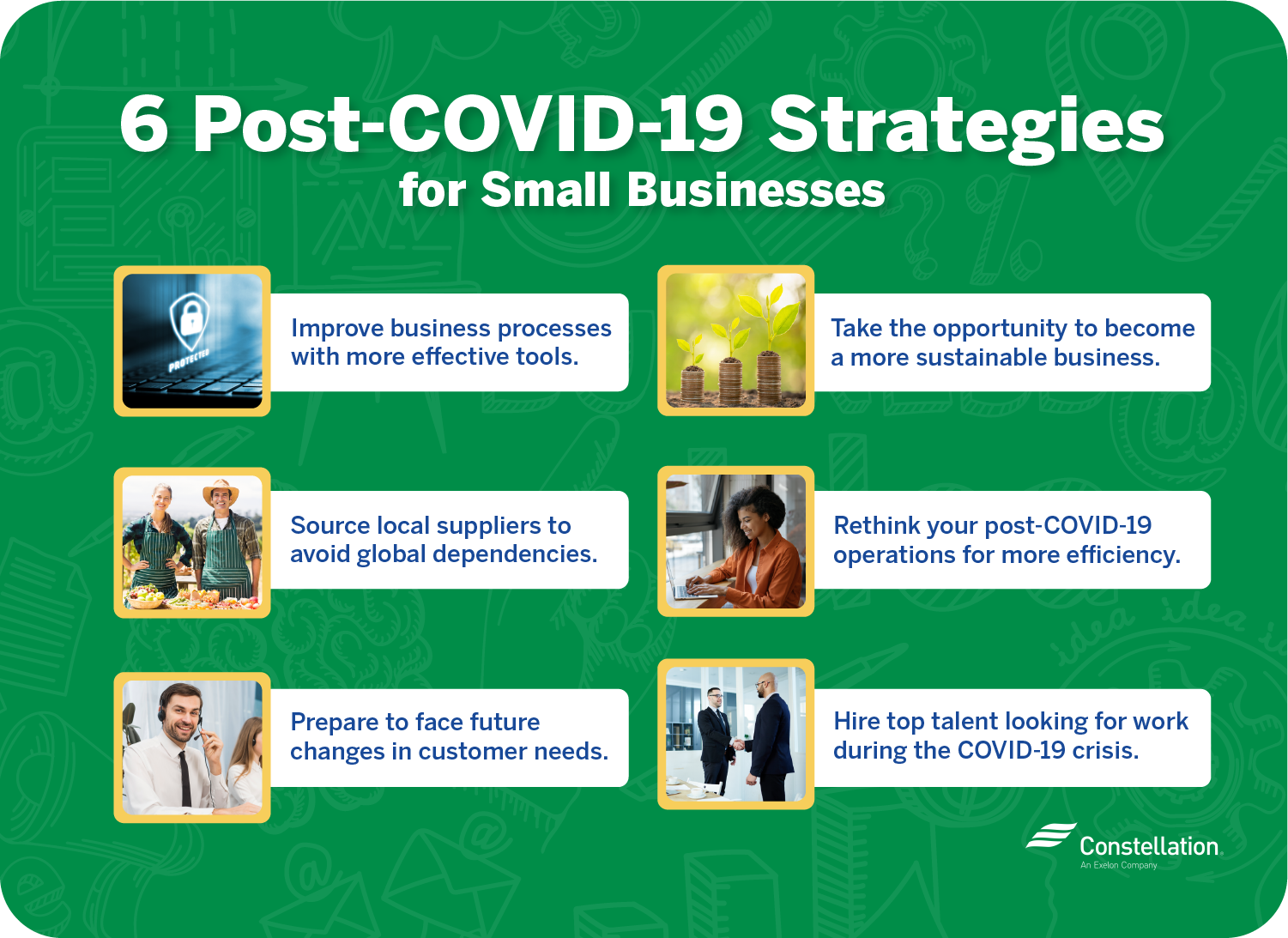
- Category:
Disaster Preparedness -
Last updated:
February 14, 2022
COVID-19: A Chance to Transform Your Business & Reinvent Your Processes
The coronavirus outbreak in the United States has changed how millions of Americans work, shop, worship, you name it. Certainly, COVID-19 has forced many small businesses to think about transforming to adapt to those new circumstances. As a small-business owner, that can feel unsettling. But there’s a good reason to forge ahead.
John Adams, the second president of the United States, once said, “Every problem is an opportunity in disguise.” In other words, business is all about taking the difficulties you’ve been given, flipping them around and finding how you can work them to your advantage. You may not like the problems COVID-19 has forced on you, but you can more than overcome them. By taking time to rethink your tools and approaches, you can make your business stronger so you better weather the next crisis and thrive in the coming economy.
What changes have hit small businesses during the pandemic?
Abruptly shutting down the economy along with multiple extensions to the shutdown have been a systemic shock to businesses of all sizes. No one had time to adequately prepare, and planning for what comes next is tricky at best.
Among the COVID-19 implications for small businesses are several operational changes that you may have faced suddenly and all at once:
- Your business operations and communication have moved online. Many businesses were already exploring online options before COVID-19 forced them to add online options or move 100% online much faster. A slow transition wasn’t possible.
- Your small business now operates under more scrutiny. One of the major COVID-19 implications is the need to operate under more government rules and regulations. Customers are also paying close attention to what your small business is doing to keep them safe from coronavirus infection.
- You may have lost your business partners because of COVID-19. A number of businesses you partnered with may not have opened yet because their suppliers are still locked down. Some may have gone (or may yet go) out of business, being unable to weather the financial strain.
- Customer demand patterns might have changed. What customers wanted a few months ago may no longer be in demand. You might find that customer priorities and needs have shifted — possibly even permanently.
- Employee needs and expectations may have changed. Workers may be balancing home-schooling, childcare, their spouse’s work schedule or even caregiving for older family members or other high-risk individuals. Motivations, especially around safety, are different now for many Americans.
6 post-COVID-19 strategies for small businesses
You may need to rethink your whole operations with some dynamic post-COVID-19 business planning. It won’t be a matter of simply snapping back and being resilient. Systemic change requires you to examine the basics in terms of customers, finances, regulations, employees, systems and operations. You’ll need to look at risks and opportunities in each area.
It’s human nature to resist change and yearn for a return to “normal.” But by thinking boldly and creatively, you may find post-COVID-19 business opportunities that create a “new normal” that’s less risky and more profitable for your business.

1. Improve your business processes with more effective tools
For many small businesses, technology has been the glue keeping things together. Connectivity and access to data has allowed staff to work remotely. Automated processes and online interaction with customers keep business moving. Cybersecurity is more important than ever.
As you evaluate your operations from the ground up, consider post-COVID-19 business ideas, including digital transformation. The months of shutdown might have uncovered weaknesses in some of your digital tools and systems. Now is the time to address any or all of the following:
- Online offerings. Not every business can be 100% online, but you may find opportunities in moving some services and interactions online. Take a look at the journey that your customers take, from exploring options, to finding your business, to booking appointments, delivering products and services, and billing, through to ongoing customer service and staying in touch. Post-COVID-19 strategies that uncover online options at every step can transform your business, replacing or adding to your in-person operations.
- Cybersecurity issues. Thieves thrive in times of disruption. Work-from-home employees, cloud computing and digital connections to customers all present opportunities for cybercriminals. Proactively adopt protective software and train your employees to recognize risks.
- Data sharing and storage capabilities. Moving to the cloud keeps data and systems accessible, allowing your employees to work from remote sites productively. You’ll need good Wi-Fi, effective mobile devices and strong security.
- Improve bandwidth. With more work done remotely and more work done online, you may need to strengthen your internet connections. Because employees save energy working from home, you might come out ahead if you pay for your employees’ home connectivity.
- Collaboration tools. You may need to invest in online meeting software, document sharing facilities, and messaging and project management applications.
2. Source local suppliers to avoid global dependencies
Many companies are changing the way they source critical inputs to their businesses. Global supply chains were a great way to find the lowest-cost supplier, but the COVID-19 pandemic forced the realization that such supply chains can be risky.
Disruption to your supply chain can be devastatingly expensive. Reshoring is the name of the trend toward domestic suppliers. Near-sourcing (placing business operations near the place where your products are sold) and multisourcing (diversifying your suppliers) are ways to buy from local partners and to keep your supply chain running smoothly.
It wasn’t long ago that lean inventories and just-in-time inventory management techniques were considered the smart and efficient way to go. Many companies are fattening up inventories to reduce risks. The cost of stopping everything to wait for a critical input could be much more expensive than tying up cash in a little bit of inventory cushion.
3. Prepare to face future changes in customer needs
Your business may face new customer expectations. Customers may want certain new protections and may actually report your business if they perceive you’re not taking their safety seriously. Keep a close eye on official regulations and talk to your customers about their expectations and how you can accommodate them.
Many small businesses faced a sudden and unexpected decline in demand for their products and services. An important post-COVID-19 strategy should be making sure that your business is ready if another disruption happens. Expect the unexpected. Take a look at how other businesses adapted. For instance, restaurant suppliers started developing packages for sale directly to consumers. Gyms started offering online trainers.
Perhaps there’s something done by a completely different kind of business that could work for you. Creative thinking that goes beyond the norm is good for situations that are outside the norm. Talk to customers about what they’re thinking and what they need. You may be able to find highly profitable new opportunities.
4. Take the opportunity to become a more sustainable small business
The economic shutdown has renewed attention to sustainability as a post-COVID-19 small-business strategy. Being smart with your money is always good business, but especially during difficult times. Adopting sustainable, energy-efficient practices now can make the difference when profit margins are at risk and under pressure. You might even be able to secure subsidized financing options for energy efficiency projects.
5. Rethink your post-COVID-19 operations and setup to achieve more efficiency
Given the current health crisis, some employees may want to permanently work from home. If your work-from-home systems are going smoothly and productivity remains high, you may be able to cut costs and increase employee satisfaction and retention by maintaining these new arrangements. For jobs that require workers being on-site, you may need to change how people work, including reducing the use of shared equipment, rearranging work stations to accommodate social distancing and staggering work schedules. And you’ll definitely want to communicate company policies on hygiene, safety, sick leave and other topics.
Increase productivity and remove bottlenecks as part of your post-COVID-19 business planning to strengthen your operations. Look at various procedures in your organization and work with your staff to take out the speed bumps and failure points. Empowering your employees to improve the efficiency of how they work — through work at home, flexible scheduling and new ways of getting the job done — can make them happier and more productive.
6. Hire top talent looking for work during COVID-19
The stress the coronavirus outbreak has put on the economy has sent unemployment soaring, meaning many good people are out of work at no fault of their own. If your small business is looking to hire, you have the potential to attract top talent that may have been otherwise out of reach before the pandemic. Even so, take care to hold on to your high-performing staff members — especially the ones who stepped up during the crisis. Your best employees, together with strong new hires, can form your dream team to help your business recover and prosper into the future.
Transition into an innovative and prosperous business
Innovation takes clever thinking, hard work and the willingness to shoulder risk. Prospering in the next economy will require fresh post-COVID 19 strategies and ideas. Business as usual is actually a risky way to operate when nothing is operating as usual. Risking change may, in fact, be the safest course of action.




